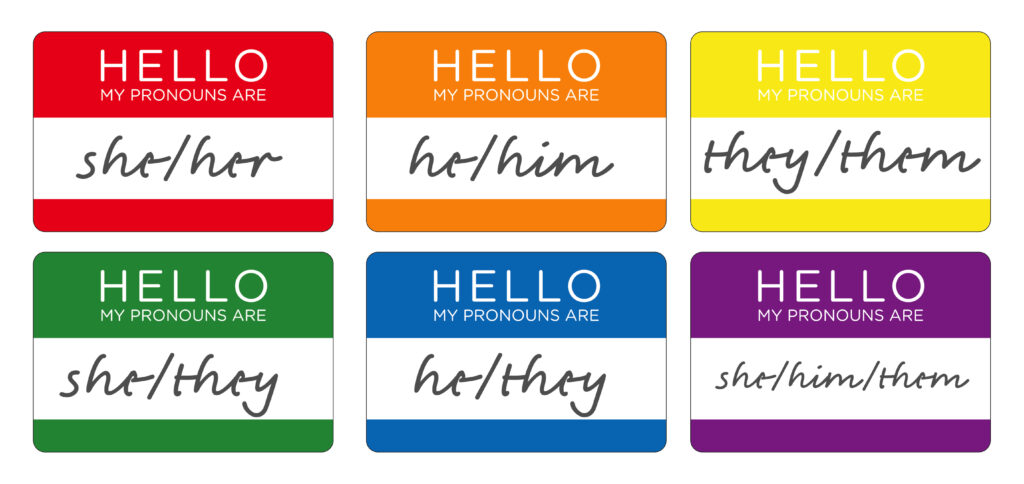
Laurie Ruettimann is a workforce expert, author, and podcaster. Please check out the homepage for her most recent books, podcasts, LinkedIn courses, and newsletters.
Pronouns never stop making the news, eliciting strong reactions from business professionals in leadership positions who may not fully understand what they are and how they function in our language.
It’s weird to talk about leaders and business professionals who might think of pronouns as a political discussion instead of a good old-fashioned tool to communicate with another human being. Are these people bigots? Or are they just misinformed? I want to assume good intent, but it’s challenging at times.
Clarifying pronouns can help us have thoughtful and considerate discussions, promoting effective communication. After all, isn’t good discourse about solving problems and facilitating understanding in our diverse world?
So let’s discuss the function of a pronoun.
Unmasking the Pronouns
Let’s get down to basics. Think of pronouns as undercover superheroes, tirelessly working to make our sentences less repetitive and more coherent. They replace nouns (people, places, things) that have already been mentioned or are obvious from the context.
There are various types of these language superheroes: personal pronouns, possessive pronouns, reflexive pronouns, demonstrative pronouns, interrogative pronouns, and indefinite pronouns. No need for a pop quiz here, but understand that each plays a unique role, adding variety to our sentences and improving language efficiency.
Imagine constantly repeating a colleague’s name in conversation. Tedious, right? For instance, consider this sentence: “John said that John was feeling sick, so John decided to stay at home.”
Doesn’t it sound repetitive? This is where our superhero pronouns step in: “John said that he was feeling sick, so he decided to stay at home.”
Much better, isn’t it? Using a pronoun instead of John’s name makes sense and helps you clearly communicate.
Pronouns and Identity: More than Just Grammar
Digging deeper, we find that pronouns serve a more profound role than merely aiding our conversations. They can express our identities, particularly when it comes to ‘gender pronouns.’
Traditionally, we use ‘he’ and ‘she’ to refer to individuals based on gender. John might be referred to as he. Jennifer might be a she. But not everyone identifies strictly as male or female. Whether you believe that the world neatly bifurcates into two distinct biological sexes and identities or if you believe identity is more personal, respect should always be at the forefront.
To honor diverse identities, It’s now common to use gender-neutral or inclusive pronouns such as ‘they,’ ‘ze,’ and ‘hir,’ or sometimes use a person’s name instead of a pronoun.
Does that seem like a lot of work for you? Correct pronouns are a straightforward but essential way to acknowledge and respect someone’s identity. It’s the language equivalent of saying, “I see you for who you are, and I respect that.”
In this context, pronouns become champions of grammar, respect, and inclusivity, just like Jesus and Jack Welch would want.
Navigating the Pronouns Journey with Respect
Respecting and acknowledging someone’s pronouns may seem unfamiliar or challenging, but these tips can guide you:
Introduce yourself with your pronouns. This practice encourages others to do the same. Always ask someone’s pronouns if you’re unsure. Practice using these pronouns privately or in writing. If you accidentally use the wrong pronoun, correct yourself, apologize, and move on. Mistakes are part of learning. Include pronouns in written communication like email signatures or social media bios. And always respect people’s pronouns.
Correct usage demonstrates respect for the individual’s identity. This isn’t about performative “wokeness” but fostering respectful communication that facilitates collaboration and mutual understanding in the business world.
It’s part of your paycheck. Beyond that, it’s just a decent thing to do.
The Power of Pronouns and the Path to Understanding
Our journey through the realm of pronouns reveals them as more than mere grammatical components; they are powerful tools for expressing identity. They have the potential to make people feel seen and acknowledged, fostering understanding and respect in our interactions.
As we strive for clear communication, we should acknowledge pronouns’ role in minimizing misunderstandings and conflicts. Pronouns extend beyond grammar to become a core component of our human interactions. They help us respect and acknowledge the diverse identities around us, contributing to a more inclusive and empathetic professional environment.
Beyond annual observances like Pride Month, let’s remember the power of pronouns. They are our hidden superheroes of language and identity. Let’s embrace them in our journey of learning, respecting, and growing together, one pronoun at a time. Through this, we can enhance our interpersonal interactions and ultimately, our professional success.
You must be logged in to post a comment.